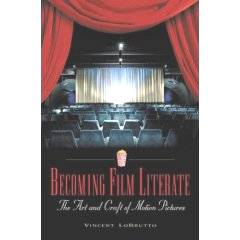Reconstruction 7.3 (2007)
Return to Contents»
Vincent LoBrutto. Becoming Film Literate : The Art and Craft of Motion Pictures . Westport, CT: Praeger, 2005, 385pp. ISBN 0-275-98144-4 (hbk), $49.95.
<1> Since the cinema's ascendancy, one has been assailed with numerous analytical concept, genres, schools and styles of filmmaking. Appreciating them all can be daunting, and so it is a pleasure to find a guide to the territory that demonstrates industry familiarity, insightfulness and clarity. This book resulted from LoBrutto's desire "to educate filmgoers about the art, craft, and lexicon of motion pictures" (xvii), and he has succeeded admirably, if inevitably incompletely, in his canvassing of only fifty topics and films aimed at Western audiences.
|
<2> Nevertheless, these fifty are a feast, namely: (1) Nonlinear Storytelling: Amores Perros, (2) Transformation of the American Comedy: Annie Hall, (3) Tableau Narrative Structure and Sound Design: Apocalypse Now, (4) The Body as Cinematic Landscape: L’Avventura, (5) Editing — Russian Montage: The Battleship Potemkin, (6) Italian Neorealism: The Bicycle Thief, (7) Production Design: Blade Runner, (8) Dream State: Blue Velvet, (9) The Period Film as Mirror for the Present: Bonnie and Clyde, (10) Expressionism in Cinema: The Cabinet of Dr. Caligari, (11) Classical Hollywood Film Style: Casablanca, (12) Surrealism in Cinema: Un Chien Andalou, (13) The Authorial Voice: Citizen Kane, (14) Shot Structure: The Crowd, (15) Thematic Unity: The Decalogue, (16) Mythopoetic Film: Dog Star Man, (17) Political Objectives through Cinematic Storytelling: Do the Right Thing, (18) Film Noir: Double Indemnity, (19) The Personal Film: 8½, (20) Animation and Music: Fantasia, (21) An American Musical: 42nd Street, (22) New York Filmmaking: The French Connection, (23) Period Comedy: The General, (24) Parallel Storytelling: Intolerance, (25) French New Wave: Jules and Jim, (26) The Epic: Lawrence of Arabia, (27) The Political Thriller: The Manchurian Candidate, (28) Self-Referential Cinema: Man with a Movie Camera, (29) Architecture in Production Design: Metropolis, (30) Roots of Documentary Film: Nanook of the North, (31) Multiplot, Multicharacter Narrative: Nashville, (32) Method Acting: On the Waterfront, (33) The Close-Up: The Passion of Joan of Arc, (34) Dark Side of American Cinema: Psycho, (35) Subtext in Personal Expression: Raging Bull, (36) Multiple Point-of-View Narrative: Rashomon, (37) Widescreen Filmmaking: Rebel without a Cause, (38) Camera Movement as Metaphor: La Ronde, (39) Mise-en-Scène: Rules of the Game, (40) Direct Cinema: Salesman, (41) The Freudian Western: The Searchers, (42) Defining Theme, Metaphor, and Character through Color, Texture, and Environmental Design: Se7en, (43) Symbolism in the Cinema: The Seventh Seal, (44) Art of the B-Movie: Shock Corridor, (45) Digital Filmmaking: Star Wars: Episode II - Attack of the Clones, (46) Birth of a Nonfiction Film Style: The Thin Blue Line, (47) Experimental Narrative: 2001: A Space Odyssey, (48) The Essay Film: Weekend, (49) Screen Violence as Metaphor: The Wild Bunch, and (50) Independent Filmmaking: A Woman Under the Influence.
<3> Linking topics with notable filmic exemplars is good mnemonic practice, yet its current clumping appears random and in need of a better structure to aid recognition, appreciation and retention. Indeed, the categories and films that he missed are puzzling, for example, religion-and-film, Jungian cinema, the trailer, the flashback, the voice-over, the remake, gangsters, subtexts, feminism, props, adaptations, J-horror, anime, pornography, screwball comedy, queer cinema. The reader will no doubt want to make many more suggestions. Although other chapters were informative, "The Authorial Voice: Citizen Kane " was simply a regurgitation of the story instead of commentary, whilst LoBrutto's passions sometimes fractured his scholarly mien, such as branding Gus Van Sant's Psycho as a "freak of cinematic nature" (234) and saying that "Elia Kazan was and remains an informer, a squealer, a rat" (217).
<4> The book is scholar friendly with an informative table of contents, glossary, bibliography and index, but a few annoying imperfections. For example, film terms were used, but not explained in the glossary, such as "future noir" (123) "serie noire" (122) and "fleuve noire" (122). Films and people referred to were missing from the index, such as "Cecil B. DeMille" (105, 147) and The Ten Commandments (105), or not all instances of the item were listed in the index, for example, "Otto Preminger" (147). There is no filmography with production details (e.g., year of release, director, producer, studio, scriptwriter, major actors, character names). Each topic has a representative film still, a synopsis, commentary, a further interest and book reading section (albeit, with limited details).
<5> As LoBrutto argued: "there is no official canon of cinema for a systematic study of the particular properties of cinematic aesthetics, concepts, and methods" (xviii). It is refreshing to see a book like this that begins to address this scholarly need. Overall, Becoming Film Literate: The Art and Craft of Motion Pictures deserves a place in any film library, whether to dip into randomly or read from cover to cover. One eagerly waits for future volumes in this exciting adventure in film literacy.
Return to Top»

